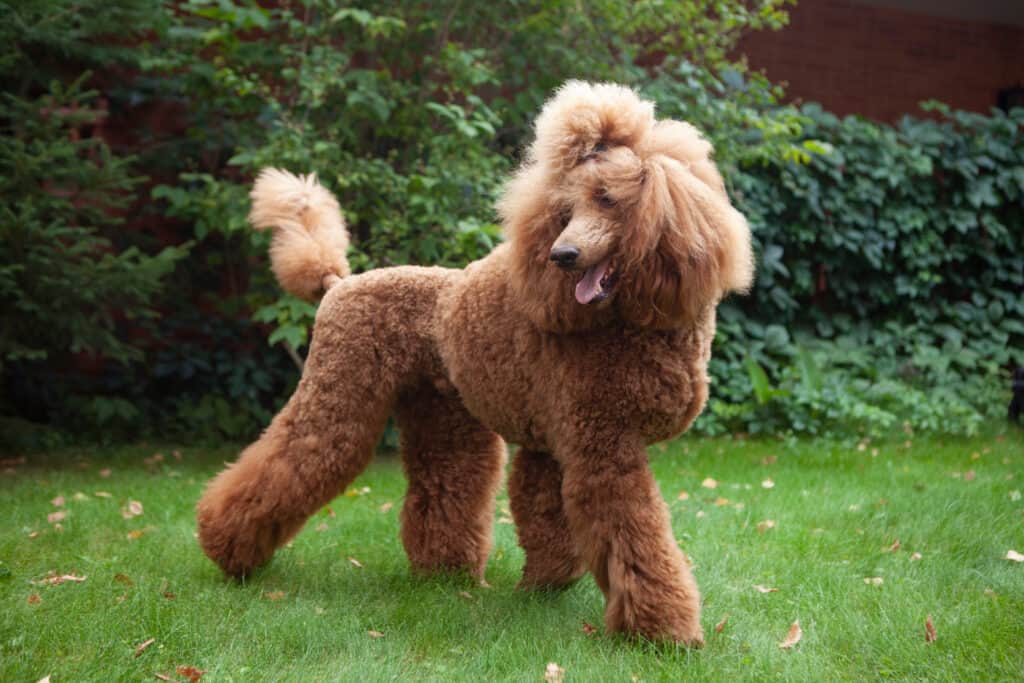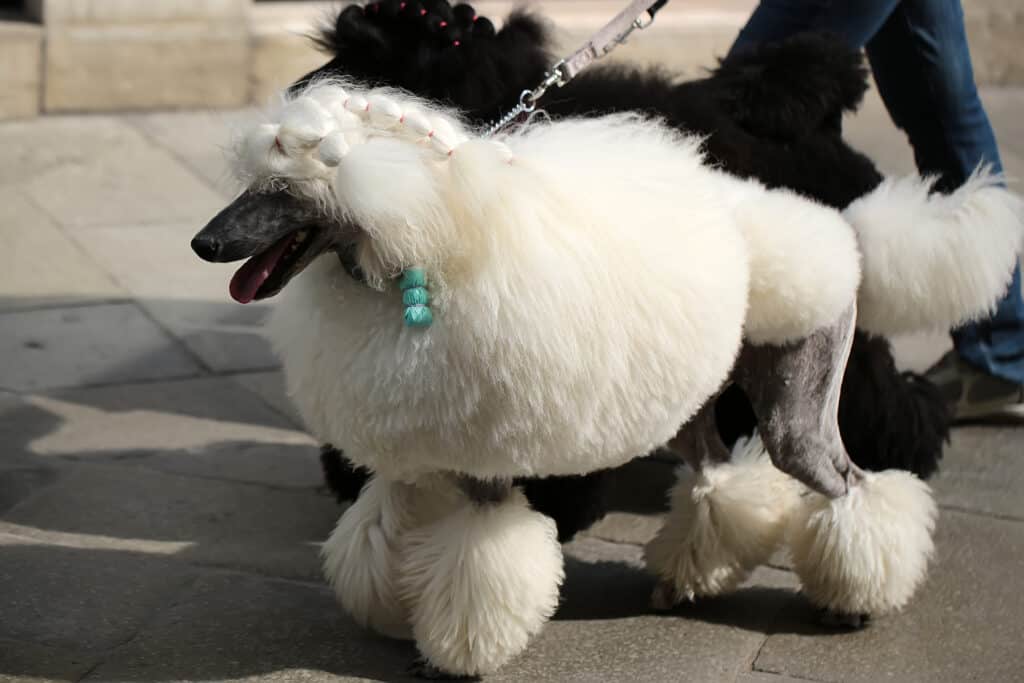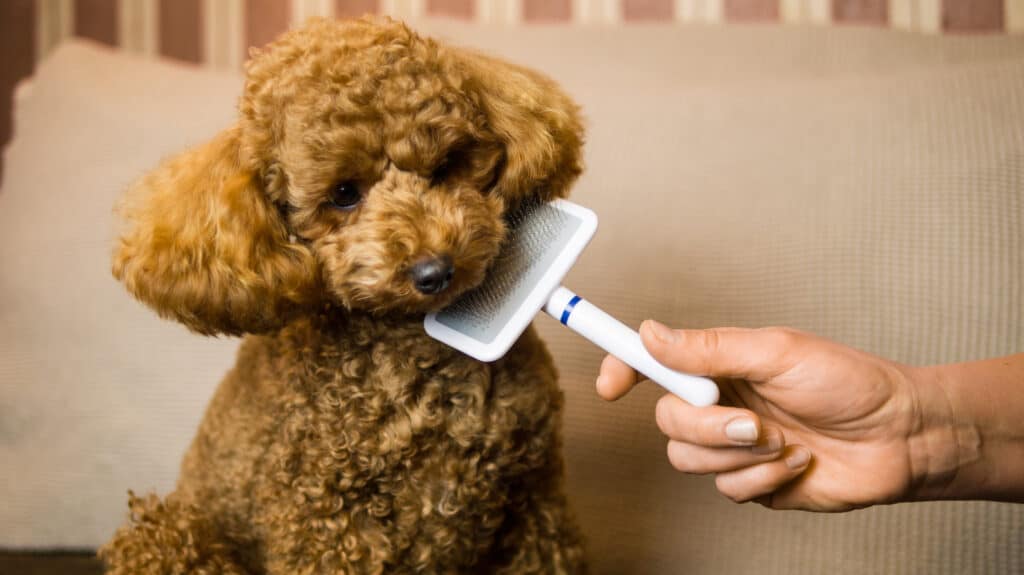Most people either love or hate the Poodle coat. If you’ve ever seen a Poodle with a standard continental cut or other long trim, you might think they’re high maintenance and shed considerably. Luckily, this isn’t true!
Poodles shed minimally because they have human-like hair, rather than fur like many other dog breeds. This hair grows continually and sheds much less. It can be high-maintenance and needs to be combed daily if kept long, but there are also short Poodle cuts that make grooming much easier.
Keep reading to learn more about Poodles and their fancy coats!
Poodle Coat Characteristics
Please note that the information below does not apply to Poodle mixes, or “doodles.” Mixing a Poodle with another breed doesn’t guarantee less shedding or a hypoallergenic coat, though irresponsible breeders often advertise them this way.
Doodles can actually have very difficult-to-groom coats depending upon the breeds mixed and are often bred unethically.
With that said, let’s dive in and talk about whether or not poodles shed, what it means when a dog has hair instead of fur, and how to groom a Poodle.
| Coat Length | Long |
| Shedding Frequency | Low |
| Grooming Needs | Comb thoroughly down to the skin once daily |
| Fur or Hair? | Hair |
| Hypoallergenic? | Yes |
Do Poodles Have Hair or Fur?
Poodles have hair, not fur. The difference between these two is that fur only grows to a certain length, while hair grows continually. Because of this, fur also sheds more frequently.
Poodles are known as a “non-shedding” breed, which means they shed like humans rather than like dogs. Just like you find your own stray hairs around the house, you’ll also find some from your pup!
Because they have hair, Poodles are also considered a hypoallergenic breed. There’s debate over whether this is simply a marketing term or whether hypoallergenic breeds truly produce fewer allergens.
Regardless, it’s agreed that hypoallergenic breeds can still set off dog allergies. Meet with the specific Poodle you want to adopt and spend time with them first so that you can be sure they won’t trigger your allergy symptoms—or at least that they’re lessened to an extent that you can deal with them on the daily.

Unlike most dog breeds, poodles have hair, rather than fur. This means they rarely shed.
©Diana Kellior/Shutterstock.com
Standard Poodle Grooming Styles
People have a ton of fun grooming Poodles and coming up with a million different styles for them! Their human-like hair is as versatile as our own.
Here are some stand-out Poodle styles, though this list is definitely not comprehensive!
Teddy Bear Cut
Personally, this is my favorite Poodle look. A teddy bear cut leaves the fur on a Poodle’s face longer and rounds it out, making it look like a cute teddy! The fur on the body is trimmed shorter.
This cut can be done at different lengths depending on your preference. It’s mostly done for aesthetic purposes but is also a pretty practical everyday look. It keeps a Poodle’s coat much easier to maintain than if it were left long.
Puppy Cut
Puppy cuts are similar to teddy bear cuts, but instead of leaving the face long, your Poodle’s fur is cut to a uniform length all over the body.
The length is up to you and your groomer, though it’s usually quite short at just a few inches.
Continental Cut
The continental cut is the cut you’re most likely to recognize on this list. It’s typically done for show dogs.
With a continental cut, the face, feet, and parts of the legs, tail, and back are all shaved. What’s left are fluffy, round patches of fur on the lower legs, head and ears, torso, and bottom of the tail.
There are also two balls of fur around your dog’s hips.
Believe it or not, this cut isn’t arbitrary or purely aesthetic. It’s actually well thought out for a working dog. The longer fur is to keep a Poodle warm, while the shaved areas help them not to be weighed down when wet.
Their shaved paws, face, and bottom stop debris from accumulating in these areas and maximize a Poodle’s vision while retrieving.
Of course, nowadays most Poodles are house pets and this cut is done for show or because the owners like the style.

The continental cut is a very popular haircut for poodles their owners are planning to enter into shows and competitions.
©Volodymyr TVERDOKHLIB/Shutterstock.com
Modern Cut
The modern cut involves trimming the body relatively short, while still allowing it that “poof” that Poodles are known for. The ears, head, and tail are kept longer for aesthetic purposes.
This cut will take more maintenance than some others on this list due to the length. Regular brushing will prevent tangles and mats from developing.
Princess Cut
With a princess cut, most of the body is shaved short. Tufts remain on the head, ears, tail, and bottom of the legs. This leaves your Poodle looking very cute, with longer hair on the head that can be styled.
This style needs a medium amount of maintenance. While most of the body is too short to comb, you will need to brush the longer areas regularly to prevent matting.
Summer Cut
A summer cut is one of the more practical cuts on this list, done primarily to keep your Poodle cool during the warmest months of the year. This is also great for hot climates or to keep your pup’s fur low maintenance. It’ll require little grooming and won’t pick up debris like a long coat might.
The basis of a summer cut is simple: your Poodle is trimmed to a uniform, short length. Keeping it at least a couple of inches can help with pests and prevent sunburn on their skin.
Winter Cut
Winter cuts are similar to summer cuts in that they’re done for practical reasons. In this case, the coat is left longer to keep your Poodle warm.
This coat may be higher maintenance, depending on the length you choose. You don’t want any tangles or mats to form in your Poodle’s fur!
How to Groom a Poodle’s Fur
Combing your Poodle
Unless your Poodle’s fur is short enough to prevent matting, you’ll need to comb it down to the skin daily. This is important to prevent fur from becoming tangled together and eventually forming into painful clumps.
Poodle fur can become difficult to deal with very quickly, so skipping out on brushing them isn’t recommended.
It’s common for their coat to mat near the skin, causing pain whenever your Poodle moves—especially if they form around the joints. Too many mats will also mean your Poodle has to be shaved down completely for their fur to regrow healthily.

It’s important to comb your poodle’s hair daily in order to avoid matting.
©Kristina Arba/Shutterstock.com
Trimming Your Poodle
Your poodle can be trimmed in any style you’d like; there’s no right or wrong! However, you should think about how much maintenance you want to put into their coat. Shorter cuts can reduce grooming time considerably when compared to longer ones.
The American Kennel Club recommends Poodles get a haircut once every four to six weeks. It’ll vary based on your preferences and which cut you give them.
Elaborate cuts are likely to look best when done by a groomer, but you can easily give your Poodle a basic haircut at home. It might not be exactly up to par with the show dogs, but it’ll save you money and your Poodle will be perfectly happy regardless!
Bathing Your Poodle
Along with a haircut, it’s also recommended that you bathe your Poodle once every four to six weeks. You can do this by first wetting the coat entirely, then scrubbing some dog shampoo into their fur and down to the skin.
Using human shampoo is not recommended. Although our hair is similar, Poodles still have different skin to humans and it might become dry or irritated by human products.
Since you’re already feeling your dog’s body, be sure to check them for any lumps, skin irritation, or pests during bath time.
Once you’ve thoroughly washed away all of the shampoos, you can follow up with a dog conditioner if you’d like. Or, simply dry them off and call it a day!
Up Next:
- Poodle Teeth: Everything You Need to Know
- Toy Poodle vs Miniature Poodle vs Teacup Poodle
- Poodle Lifespan: How Long do Poodles Live?
- Toy Poodle Lifespan: How Long do Toy Poodles Live?
The photo featured at the top of this post is © eAlisa/Shutterstock.com
Sources
- Sarah Zhang, Available here: https://www.theatlantic.com/health/archive/2022/09/hypoallergenic-dog-allergies/671439/
- Jean Bauhaus, Available here: https://www.akc.org/expert-advice/health/dog-skin-lumps-bumps-when-you-should-worry/
- Amy Flowers, Available here: https://pets.webmd.com/dogs/ss/slideshow-skin-problems-in-dogs
- Harriet Meyers, Available here: https://www.akc.org/expert-advice/health/how-to-get-rid-of-fleas/
Thank you for reading! Have some feedback for us? Contact the AZ Animals editorial team.






